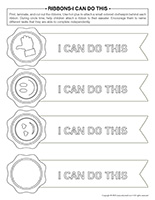
CIRCLE TIME
Wearable “I can do this” ribbons
(Open ribbons-I can do this) Print, laminate, and cut out the ribbons. Use hot glue to attach a small colored clothespin behind each ribbon. During circle time, help children attach a ribbon to their sweater. Encourage them to name different tasks that they are able to complete independently.
I can talk about my autonomy…using a puppet
Use a puppet to encourage children to speak about different subjects related to autonomy. The puppet may help some children overcome their shyness. It may also help those who require language support. One thing is certain, the puppet will spark an interest in your conversation!
AREA SETUP
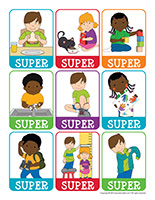
Thematic poster-Autonomy
(Open thematic poster-Autonomy) Print, laminate, and display where parents are sure to see it.
Stickers-Autonomy
(Open stickers-Autonomy) Print on adhesive paper to create a collection of original stickers.
Educa-theme-Autonomy
(Open educa-theme-Autonomy) Print and laminate the different elements representing the theme. Use them to present the theme to your group (and parents) while decorating your daycare.
Educa-decorate-Autonomy
(Open educa-decorate-Autonomy) Print, laminate, and cut out the illustrations. Use them to decorate your walls and set the mood for the theme.
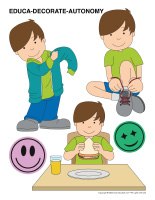
Garland – Autonomy
(Open models-Autonomy) Print and let children decorate the items. Cut them out and hang them on a ribbon or string to create a garland that can be used to decorate your daycare entrance or playroom.
Interactive identification cards – Autonomy
(Open interactive identification cards-Autonomy) Type the name of each child on an identification card. Save and print the document. You can print it on adhesive paper and press the identification cards directly on children’s clothing or, if you prefer, you can print them on heavy paper, punch a hole at the top of each card, and thread a piece of string through. Children can wear their identification card like a necklace. The identification cards may also be used to identify children’s spaces and personal belongings.
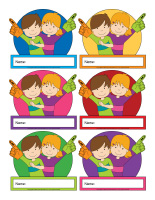
Interactive planning-Autonomy
(Open interactive planning-Autonomy) Type your planned activities directly in the document, save it, and print it. Use the document as a guide for the presentation of thematic activities each day.
Autonomy benches
For the duration of the theme (or permanently), you will need a sturdy bin with a lid for each child in your group. Children must be able to sit on their bin to put their shoes on or to get dressed. Have each child decorate his bin in a way that will make it easy to recognize. Show children how they can set their personal items (hat, sunscreen, sweater, coat, etc.) in their bin. Line you autonomy benches up against a wall in your daycare entrance or cloakroom. Whenever you go outside, encourage children to take the items they need out of their bench and then sit on it to get ready and wait as their peers finish getting ready.
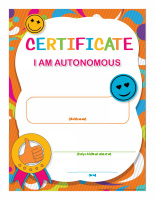
Interactive diploma-Autonomy
(Open interactive diploma-Autonomy) Type the name of a child on the diploma before saving it and printing it. You can pick a different child to reward with a diploma each day throughout the theme.
PICTURE GAME
Picture game-Autonomy
The pictures can be used as a memory game or to spark a conversation with your group. Use them to decorate your daycare or a specific thematic corner. (Open picture game-Autonomy) Print, laminate, and store in a Ziploc bag or in your thematic bins.
ACTIVITY AND WRITING SHEETS
Activity booklet for free time-Autonomy
(Open activity booklet for free time-Autonomy) Print for each child. Children complete each page per the instructions.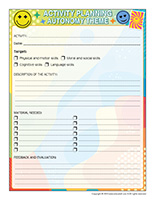
Writing sheet-Autonomy
(Open writing activities-A like Autonomy) Print for each child or laminate for use with a dry-erase marker.
LANGUAGE ACTIVITIES
Word flashcards-Autonomy
The flashcards may be used to spark a conversation with your group, in your reading and writing area, or even to identify your thematic bins. (Open word flashcards-Autonomy) (Open giant word flashcards-Autonomy) Responsible, autonomous, to grow, personality, routine, tasks, to explore, challenge, to get dressed, to eat, to learn, to discover.
Educa-chatterbox-Autonomy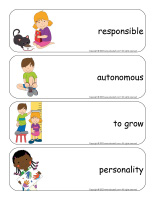
(Open educa-chatterbox-Autonomy) Print and laminate the cards. To create your chatterbox, you will need an empty shoebox or a small bin that you can decorate as you see fit. Fill it with tiny objects, illustrations, pictures, and accessories related to your theme. To help you, we have created a series of cards that you may use. During circle time or, for example, when children are waiting for their lunch, have them take turns picking a card or object out of your chatterbox and naming the corresponding item.
Animated discussion-Autonomy wheel
(Open autonomy wheel) Print, laminate, and cut out the arrows. Make a tiny hole in the center of the wheel and insert a fastener to hold the arrows in place. To solidify your wheel, you can simply glue it on a paper plate. Use the wheel to spark a conversation with your group during circle time. Invite a child to spin the arrows. Ask children questions about the illustrations the arrows point to in order to explore the theme.
To help, I can…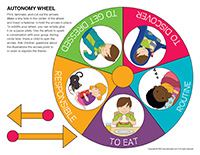
(Open card game-To help) Print, laminate, and cut out the cards. Invite children to take turns picking a card and completing the sentence that is printed on it to encourage them to speak and explore the theme.
ACTIVITIES FOR DEVELOPING AUTONOMY
PHYSICAL ACTIVITY AND MOTOR SKILLS
Pompom sweep
To help children learn to use a broom and dustpan, empty the contents of several bags of pompoms on your daycare floor. Provide different brooms and dustpans (toy or full size) and encourage children to clean up the pompoms. They can push or slide the pompons onto the dustpans and empty them in a large bucket or bin.
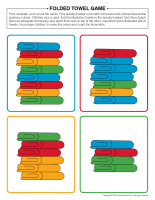
The folded towel game
(Open folded towel game) Print, laminate, and cut out the cards. Fill a laundry basket or bin with numerous bold-colored facecloths (primary colors). Children pick a card, find the illustrated towels in the laundry basket, fold them (teach them an adequate technique), and stack them one on top of the other, reproducing the illustrated pile of towels. Encourage children to name the colors and count the facecloths.
Modeling dough activity placemats-Autonomy
(Open modeling dough activity placemats-Autonomy) Print and laminate. Let children pick a placemat and provide modeling dough. Encourage them to use the dough to fill or reproduce the shapes that are on their placemat.
The challenge bag
Discuss with your group in order to identify challenges or things they feel they could improve. Write each challenge on a small piece of cardboard and set them in a colorful bag (one bag per child). At the beginning of the week, have each child pick a challenge out of their bag. At the end of the week, children who successfully completed their challenge can drop a a plastic precious stone in their bag. Continue until children’s bags contain only precious stones.
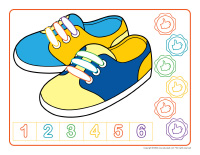
Responsibilites
(Open responsibility chart) Print. Display the chart where children will see it. Daily, attribute one task or responsibility to each child, making sure that the tasks and responsibilities do not surpass their capacities. Positively reinforce children as they complete their tasks.
Routines
(Open getting dressed routine-At the pool) Arrange the illustrations on a wall in your cloakroom, at children’s eye level. Accompany children to help them follow the sequence.
Autonomy during the getting dressed routine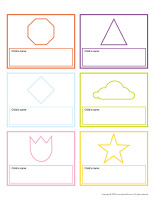
This activity is perfectly suited for older toddlers who are beginning to dress themselves. You will need large stickers. Every time children put a clothing item on (with or without help per their age), press a sticker on it: a sticker on their hat, a sticker on each shoe, a sticker on their coat, etc. Supervision is necessary.
Cleaning
Invite children to participate in cleaning tasks. Encourage them to help you pick up and clean toys. This represents a great way to foster autonomy and as an added bonus, you will tidy up your daycare faster. Young children will see this task as a game. Even very young children can help, for example by washing paint off a table with a moistened cloth.
Who do these items belong to?
Grab a pair of shoes and ask the child they belong to to go hide. When another child arrives, have him guess who the shoes belong to. Once he has named the correct child, he must search for him.
Getting dressed steps-Winter clothes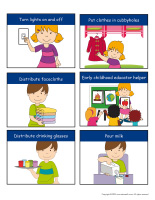
(Open getting dressed for winter routine) Print, laminate, and display the illustrations on a clothesline in your cloakroom. Use them to teach children to get dressed for outdoor play, adding clothing items per the illustrated order.
COGNITIVE DEVELOPMENT
Lacing shoes
(Open lacing-Shoes) Print in color and laminate for each child. Using a hole-punch or the tip of a pen, punch 3 holes on either side of each shoe tongue. Set a plastic dish containing several pieces of yarn (same colors as the shoes) on the table. Children must thread a “shoelace” of the corresponding color through the holes on each shoe. Older children can try to tie the shoes if the pieces of yarn are long enough. Help younger children if necessary. Encourage children to name the color of each shoe.
Counting cards – Autonomy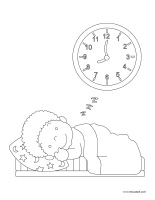
(Open counting cards-Autonomy) Print and laminate. Write or paint numbers 1 to 9 on a series of clothespins prior to this activity. Children must count the items in each rectangle and press the clothespin with the correct number on it on the corresponding number at the bottom of each card.
Coloring hunt and seek-Autonomy
(Open coloring hunt and seek-Autonomy) Print and laminate. Children must find and color the items shown at the bottom of the page.
Big and small-Autonomy
(Open big and small-Autonomy) Print and laminate the game. Children must arrange the items in order, from smallest to biggest, and press them in the squares using Velcro or adhesive putty.
Educ-ascending-descending-Autonomy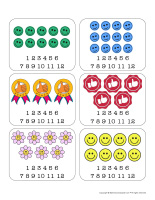
(Open educ-ascending-descending-Autonomy) Print and laminate the cards. Children must place identical items in ascending or descending order.
Educ-math-Autonomy
(Open educ-math-Autonomy) Print and laminate for durable, eco-friendly use. Children must count the objects in each rectangle and circle the correct number.
I can set the table
(Open game-I set the table in color) Print and laminate the placemats. Fill a large bin with disposable plates, drinking glasses, straws, and utensils corresponding to the colors of those illustrated on the placemats. Invite children to pick a placemat and find the plate, glass, straw, and utensils shown and set them on their placemat, like a puzzle.
Wall hooks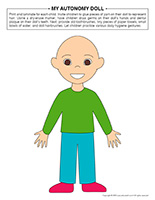
Press small hooks on a wall, just above children’s heads. Encourage them to hang and remove various items: clothing, fabric bags, scarves, etc. This fun yet simple game will help prepare children so that they can later hang their clothes in your cloakroom independently.
MORAL AND SOCIAL DEVELOPMENT
My autonomy doll
(Open my autonomy doll) Print and laminate for each child. Invite children to glue pieces of yarn on their doll to represent hair. Usine a dry-erase marker, have children draw germs on their doll’s hands and dental plaque on their doll’s teeth. Next, provide old toothbrushes, tiny pieces of paper towels,small bowls of water, and doll hairbrushes. Let children practice various daily hygiene gestures.
Shoe puzzles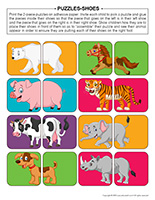
(Open puzzles-Shoes) Print the 2-piece puzzles on adhesive paper. Invite each child to pick a puzzle and glue the pieces inside their shoes so that the piece that goes on the left is in their left shoe and the piece that goes on the right is in their right shoe. Show children how they are to place their shoes in front of them so as to “assemble” their puzzle and see their animal appear in order to ensure they are putting each of their shoes on the right foot.
Emotional autonomy box
Create a special box (that children can decorate) and set in a corner of your daycare. Children can insert their emotions in the box by opening it and speaking into it or, if they prefer, by sliding a drawing representing an emotion inside the box.
Fostering autonomy and helpfulness
Sit on the floor with your group. Stretch your arm out in front of you, pretending that you are unable to reach a toy. Ask children to help you reach it.
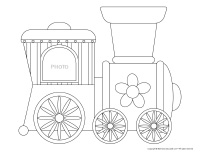
Picture box
Drop a picture of each child in your group inside a special box. Use this box to determine the order in which children get to play or participate in an activity or routine (hand washing, bathroom, getting dressed, etc.). Simply pick the pictures out of the box to determine whose turn it is next.
ARTS & CRAFTS
Ride the autonomy train
(Open autonomy train) Print a train and train station for each child. Invite them to color them and cut them out. Give each child a large piece of cardboard and draw a winding path (2 parallel lines). Have children draw lines to represent a railroad and create boxes. Have them glue their train at one end of the railroad and press their train station at the opposite end. Children can draw themselves in their train or add a picture of their face. Every time you notice a child completing a task or routine autonomously, congratulate him and hand him a sticker he can press in a box, on his railroad.

Autonomy superhero cuffs
Here, you will need several empty toilet paper rolls so that you have 2 per child. Invite children to paint them using the color they prefer. Let dry. (Open symbols-superhero cuffs) Print, laminate, and cut out the different symbols. Help children cut both of their toilet paper rolls lengthwise so that they can slide them onto their wrists. They can glue a symbol on the uncut portion of each of their cuffs. Encourage them to wear their cuffs to make them feel like autonomy superheroes and push them to complete various tasks and routines independently.
COLORING PAGES
Coloring pages-Autonomy
(Open coloring pages-Autonomy) Print for each child.
Have fun!
The educatall team
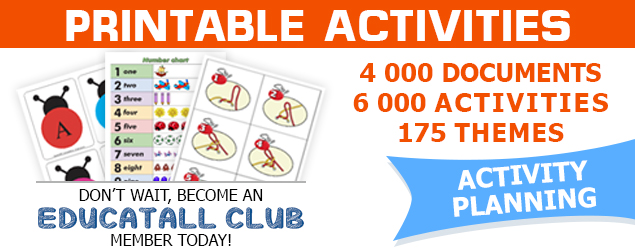
 Home
Home Theme activities
Theme activities
 Babies and toddlers
Babies and toddlers
 Arts and crafts
Arts and crafts
 Science
Science
 Creative recipes
Creative recipes
 Tips and tricks
Tips and tricks
 Special needs
Special needs
 Extra activities
Extra activities
 Educ-TV
Educ-TV
 Newsletter
Newsletter  Online store
Online store Educatall club
Educatall club

